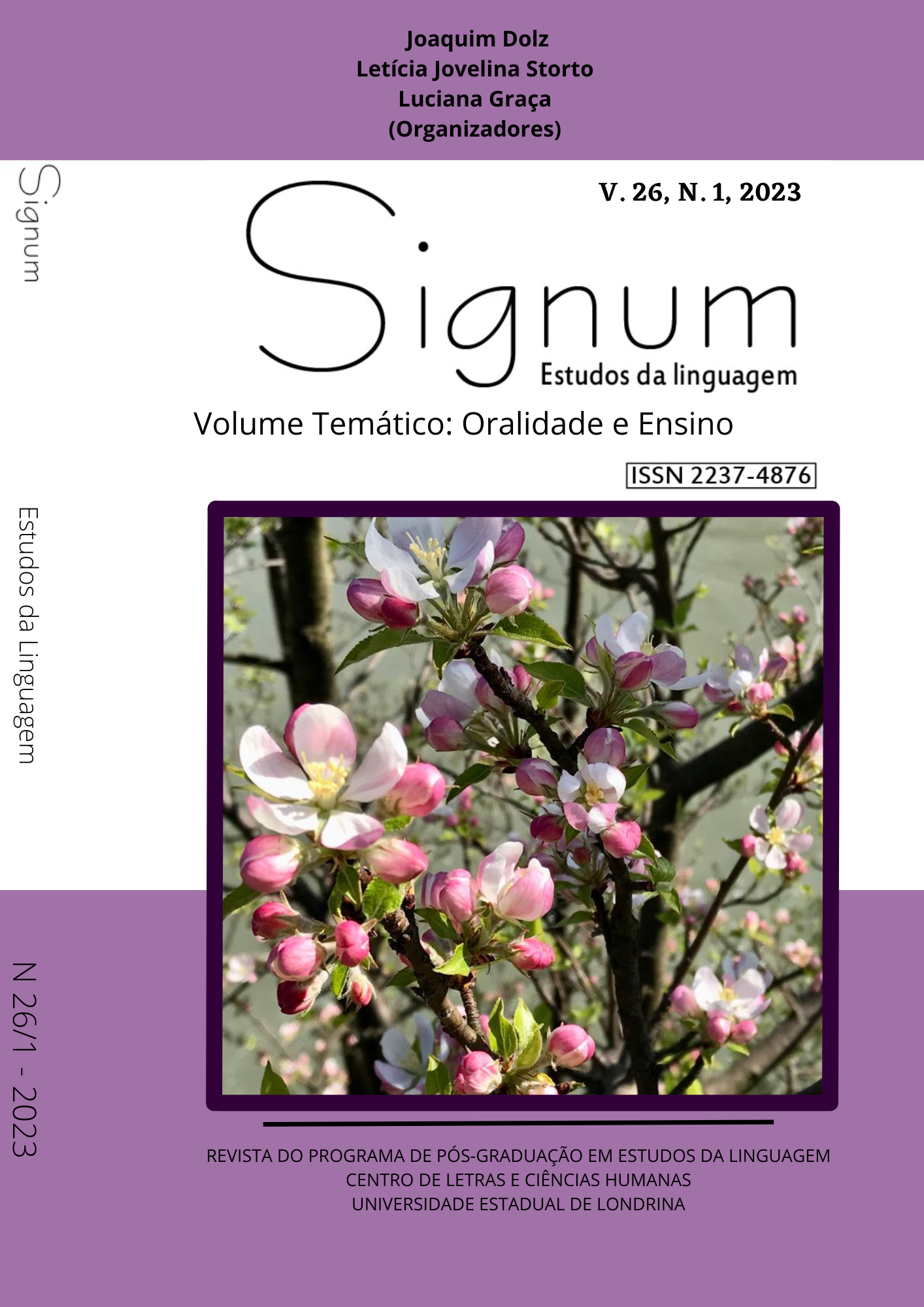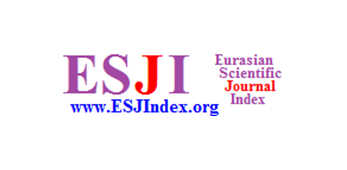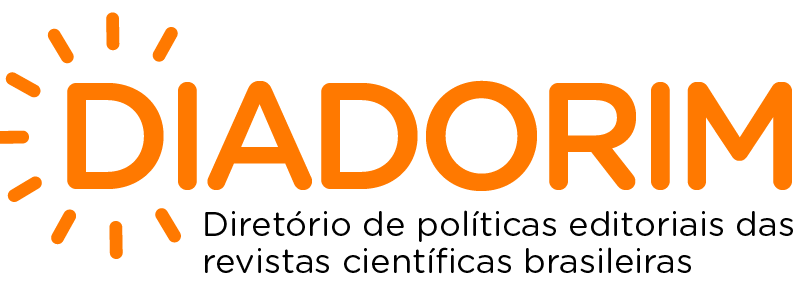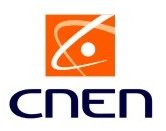Turns for Conversation and Voice Overlap
a teaching proposal to work with orality in the classroom
DOI:
https://doi.org/10.5433/2237-4876.2023v26n1p119Keywords:
Turns for conversation, Voice overlap, TeachingAbstract
This article aims to show how overlapping voices can be configured in levels of complexity in interaction during the textual production of the genre debate in the classroom and proposes the applicability of conversational turns as an oral category for teaching orality, for means of activity about turn taking. To support this research, we relied on concepts of Conversation Analysis, such as conversational turns and overlapping voices (GALEMBECK, 1999, URBANO, 1999; PRETI, 1999, SACKS; SCHEGLOFF; JEFFERSON, 2003; MARCUSCHI, 2003). The research, of a qualitative nature, has as subjects a class of the 6th and a class of the 7th year of elementary education from two schools in Fortaleza-CE. The data collection process took place from the audio and video recording of the students' oral textual productions, which were transcribed according to the NURC standards. These procedures led to the construction of a corpus of 30 class hours. For this work, however, we selected only three classes from the corpus to demonstrate that there are at least three levels of overlapping of voices, which evolve gradually from initial to advanced overlapping. The last two levels are configured, therefore, as a turn taking.
Downloads
References
BEZERRA, Benedito G. O gênero como ele é (e como não é). São Paulo: Parábola Editorial, 2022.
BRASIL. Base nacional comum curricular: ensino médio. Brasília, DF: MEC/SEB, 2017.
CRUZ, Fernanda M. da; OSTERMANN, Ana Cristina; ANDRADE, Daniela N. P.; FREZZA, Minéia. O trabalho técnico-metodológico e analítico com dados interacionais audiovisuais: a disponibilidade de recursos multimodais nas interações. DELTA, São Paulo, SP, p. v. 35, n. 4, p. 1-36, 2019. DOI: https://doi.org/10.1590/1678-460x2019350404
FERREIRA, Elaine C. F. A oralidade como objeto de ensino: por uma perspectiva de desenvolvimento da língua oral a partir do gênero debate. 2014. 229 f. Tese (Doutorado em Linguística) - Universidade Federal do Ceará, Fortaleza, 2014.
FORTE-FERREIRA, Elaine C.; SOARES, Juliana G.; LIMA-NETO, Vicente. A influência de elementos cinésicos no gênero debate político: aspectos da multimodalidade na argumentação. Revista da ABRALIN, Aracaju, SE, v. 20, n. 3, p. 1550-1570, 2022. DOI: https://doi.org/10.25189/rabralin.v20i3.1966
FRAZÃO, Elisiane A. S.; LIMA, Veraluce S. Análise da conversação no Brasil: os desdobramentos de um campo de formação multidisciplinar. Entrepalavras, Fortaleza, CE, v. 7, n. 2, p. 622-637, ago./dez. 2017. DOI: http://dx.doi.org/10.22168/2237-6321.7.7.2.622-637 DOI: https://doi.org/10.22168/2237-6321.7.7.2.622-637
FREITAG, Raquel M. K.; SANTANA, Rebeca R. Assalto ao turno em interações assimétricas de gênero: disputa e cooperação. Cadernos de Linguagem e Sociedade, Brasília, DF, v. 20, n. 1, p. 53-65, 2019. DOI: 10.26512/les.v20i1.11254. DOI: https://doi.org/10.26512/les.v20i1.11254
GALEMBECK, Paulo T. Metodologia de pesquisa em português falado. In: RODRIGUES, Angela C. de S.; SANTANA, Ieda M.; GOLDSTEIN, Norma S. (org.). In: SEMINÁRIO DE FILOLOGIA E LÍNGUA
PORTUGUESA, 1., São Pulo, SP. Anais [...]. São Paulo: Humanitas/ FFLCH/ USP, 1999. p. 109-119.
GARCEZ, Pedro M. A perspectiva da análise da conversa etnometodológica sobre o uso da linguagem em interação social. In: LODER, Letícia L.; JUNG, Neiva M. (ed.). Fala-em-interação social: uma introdução à análise da conversa etnometodológica. Campinas, SP: Mercado de Letras, 2008. p. 17-38.
JANSON, Tore. Línguas ágrafas. In: JANSON, Tore. A história das línguas: uma introdução. São Paulo: Parábola, 2015. p. 14-35.
KERBRAT-ORECCHIONI, Catherine. Análise da conversação: princípios e métodos. São Paulo: Parábola Editorial, 2006.
LEITE, Marli Q.; NEGREIROS, Gil. Análise da conversação no Brasil: rumos e perspectivas. In: GONÇALVES, Adair V.; GÓIS, Marcos L. S. (org.). Ciências da linguagem: o fazer científico. Campinas: Mercado das Letras, 2014. p. 105-135.
MARCUSHI, Luiz A. Análise da conversação. 5. ed. São Paulo: Ática, 2003. (Série Princípios).
MAREGA, Larissa M. P.; JUNG, Neiva M. A sobreposição de falas na conversa cotidiana: disputa pela palavra? Veredas: Revista de Estudos Linguísticos, v. 1, p. 321-337, 2011.
OSTERMANN, Ana Cristina; PEROBELLI, Roberto. Novos estudos do letramento e análise da conversa: o ajuste ao interlocutor em práticas de Letramento em Saúde. Revista da Anpoll, Brasília, DF, v. 1, n. 49, p. 142-157, 2019. ISSN 1982-7830 versão online. DOI: https://doi.org/10.18309/anp.v1i49.1308
PRETI, Dino F. (org.). Análise de textos orais. 4. ed. São Paulo: Humanitas, 1999.
SACKS, Harvey; SCHEGLOFF, Emanuel A.; JEFFERSON, Gail. Sistemática elementar para a organização da tomada de turnos para a conversa. Veredas: Revista de Estudos Linguísticos, Juiz de Fora, MG, v. 7, n. 1/2, p. 9-73, Jan./Dec. 2003.
o ENCONTRO dos presidenciáveis (Rede Bandeirantes 16/10/1989). [S. l.: s. n.], 1989. 1 vídeo (2h59min.:23). Publicado pelo Canal VJR Eleições. Disponível em: https://www.youtube.com/watch?v=ME42kd-2wOE&t=3052s. Acesso em: 27 ago. 2022.
URBANO, Hudinilson. Marcadores conversacionais. In: PRETI, Dino F. (org.). Análise de textos orais. 4. ed. São Paulo: Humanitas, 1999. p. 81-102.
VOLÓCHINOV, Vladimir. Marxismo e filosofia da linguagem: problemas fundamentais do método sociológico na ciência da linguagem. Tradução de Sheila Grillo e Ekaterina V. Américo. São Paulo: Editora 34, 2018.
Downloads
Published
How to Cite
Issue
Section
License
Copyright (c) 2023 Elaine Cristina Forte-Ferreira, Vicente Lima-Neto

This work is licensed under a Creative Commons Attribution-NonCommercial-NoDerivatives 4.0 International License.
This journal reserves the right to make, in the originals, normative, orthographic and grammatical modifications in order to maintain the standard language and the credibility of the publication. It will respect, however, the authors’ style of writing. Modifications, corrections and suggestions of conceptual order will be forwarded to the authors, if necessary. In these cases, the papers, once appropriate, should be submitted to a new appreciation. The final examinations will not be forwarded to the authors. Works published become property of Signum, being its total or partial reprint subject to an explicit authorization of the journal. In all subsequent quotes the original source of publication should be mentioned, in case, in Photographic Discourse. Opinions emitted by the authors are their exclusive responsibility.















